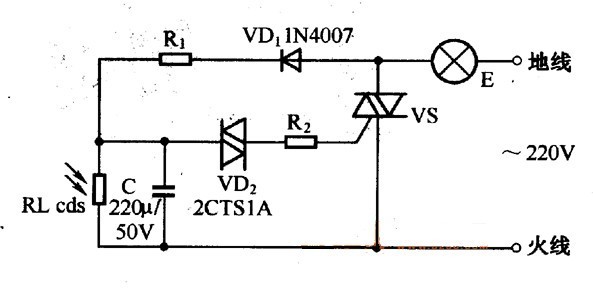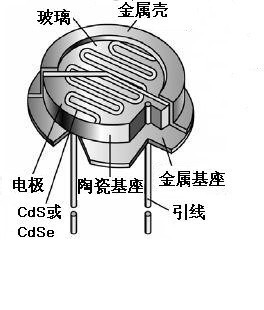In the public places of schools, institutions, factories and mines, and public corridors in residential areas, the phenomenon of long-lighting is very common, which has caused great waste of energy. In addition, due to frequent switching or human factors, the damage rate of the wall switch is high, which increases the amount of maintenance and wastes money. In order to alleviate this situation, this article brings you a kind of energy-saving light control class, which is simple in structure, easy to install, can be fixed on the wall of the door, and has long service life, safety and energy saving, in line with the national energy conservation and environmental protection concept.
First, the main characteristics and application of lighting
Design light control lighting, when there is light signal at night (black cover simulation), make the light delay after 5 seconds and then turn off. If the interval is less than 5 seconds, the light will remain on and the light will not light during the day. During the daytime, the light is strong, and the light control circuit in the switch works to cut off the circuit. When the light is dimmed to a certain degree, the circuit is turned on, and the power of the lamp is turned on, and the light is on. After a delay, after the light is on for several tens of seconds, the one-shot circuit automatically flips and the light goes out.
From the structure analysis of the light control switch, the surface of the switch panel is equipped with a photosensitive diode, and the sensitive effect of the photodiode only works in the dark (measured by a liquid crystal multimeter). That is to say, the color of the day becomes dark to a certain extent, and the photosensitive diode generates a pulse current on the electronic circuit board after induction, and the light control switch circuit is connected to function.
The voice control lamp includes a lamp load RL, a thyristor SCR, a lamp load RL and a thyristor SRC connected in series with the power source. The light-controlled electronic switch, its "on" and "off" is achieved by the conduction and blocking of the thyristor, and the conduction and blocking of the thyristor is subject to the brightness of natural light (or brightness) The size is controlled by.
1.1, the main features and advantages of the circuit have the following aspects:
(1) Light control function: when the lighting meets the need, the light is not turned on;
(2) Stability: an efficient and reliable constant current source to ensure the stability and longevity of the LED light source;
(3) Wide voltage: AC70V~260V adaptive, DC11V~60V adaptive, suitable for areas with large voltage fluctuations;
(4.) Adaptability: The test works normally at -20 ° C ~ 60 ° C ambient temperature;
(5), color rendering: color rendering ≥ 70 Ra, while the intermediate color temperature gives comfortable lighting;
(6) Reliability: All solid-state light sources are resistant to vibration and impact;
(7) Long life: LED service life ≥ 50,000 hours, greatly reducing labor and material costs for lamp replacement;
(8), no pollution: general fluorescent lamps contain harmful substances such as mercury, and LED lamps use semiconductor technology, do not contain any harmful substances, is a veritable green light source;
(9), parameter self-setting: the user can adjust the sensitivity, infrared (sound control) sensitivity, delay time and other parameters by simple plugging and unplugging (or adjustable device).
1.2, the main application occasions:
1) Solar photovoltaic lighting systems;
2) Lighting of public passages such as building corridors and walkways;
3) Supplementary lighting in large environments such as underground garages, libraries, museums, exhibition halls, and supermarkets;
4) Lighting of entrances, kitchens, bathrooms, storage rooms and changing rooms in hotels, hospitals and residences;
5) Lighting of battery-powered places such as train cars and ship tents.
Second, the circuit schematic and the working principle of each device
2.1 circuit schematic

Figure 1 circuit schematic
The circuit of the light control light switch is shown in the dotted line in Figure 2-1. VS is a common unidirectional thyristor whose trigger signal is obtained by the voltage division of the resistor R and the photoresistor RL to 220V alternating current (ignoring the electric filament resistance). VD is a common diode and is mainly used to prevent the reverse voltage of the RL from being damaged by the VS control electrode. During the daytime, the ambient natural light is strong, RL is low resistance (≤2kΩ, the AC voltage at RL is less than the conduction voltage of VD and VS control electrode (about 0.65V+0.65V=1.3V), VS is in the blocking state, the electric light H is not bright; at night, the ambient natural light is dimmed, RL is high resistance (>1MΩ), VS obtains sufficient trigger voltage from both ends of RL to conduct, and H power automatically lights up.
Since the brightness of the lamp is gradually darkened by the natural light of the outside when the night light is turned on, it avoids the use of the ordinary mechanical switch, and the instant of turning on the light is 10 times larger than the normal time. The above-mentioned strong current impact on the filament effectively prevents the overcurrent loss of the filament; in addition, the half-wave pulse voltage is applied to both ends of the H operation, and the measured average DC voltage is about 99V, and the actual power of the bulb is only the nominal power. About 30%, this not only saves electricity, but also effectively prevents the filament overvoltage loss caused by the increase of the night deep grid voltage, so that the lamp life is greatly extended. The lighting lamp in the toilet of the author, before using this switch, replace 2-3 incandescent bulbs every month. Now use this switch for more than a year, and have not replaced one bulb. The switch consumes very little power during the day, and the measured total current is <22μA.
2.2 Photosensitive resistor

Figure 2 Photoresistor
Photosensitive resistor (photovaristor) is also called photo-sensing resistor. It is a resistor made by the photoelectric effect of semiconductor. The resistance value changes with the intensity of incident light. The incident light intensity, the resistance decreases, the incident light is weak, and the resistance Increase. Photoresistors are commonly used for light measurement, light control, and photoelectric conversion (converting changes in light into electrical changes). Typically, the photoresistor is formed into a sheet structure to absorb more light energy. When it is irradiated with light, an electron-hole pair is excited in the semiconductor wafer (photosensitive layer) to participate in conduction, so that the current in the circuit is enhanced.
A photoresistor is a semi-physical device that utilizes the photoelectric effect of a half-pickup. The resistance is small when there is light. The resistance is large when there is no light. A transistor can be used to form an amplifier to make an automatic control circuit. Implement the circuit you need. The photoresistor is used as a biasing resistor of the transistor. This way the transistor turns on when there is light, driving the sensitive relay. Turn on the motor with a relay. Open the curtains. The relay can be used with JRX--13F sensitive relay. Its pull-in current is no more than 50MA. The preamplifier can be made up of Darlington tubes. An inverter can be connected to the amplifier. The inverter drives the relay. The materials used to make the photoresistor are mainly semiconductors such as sulfides, selenides and tellurides. In the dark environment, its resistance value is very high. When the light is received, as long as the photon energy is greater than the forbidden band width of the semiconductor material, the electrons in the valence band absorb the energy of a photon and can transition to the conduction band and in the valence band. A positively charged hole is generated, and the electron-hole pair generated by the illumination increases the number of carriers in the semiconductor material, making the resistivity small, thereby causing the photoresistor resistance to decrease. The stronger the light, the lower the resistance. After the incident light disappears, the electron-hole pairs generated by the photon excitation will gradually recombine, and the resistance of the photoresistor will gradually return to the original value. Visible light photoresistors: including selenium, cadmium sulfide, cadmium selenide, cadmium telluride, gallium arsenide, silicon, germanium, zinc sulfide photoresistors. Mainly used in various photoelectric control systems, such as photoelectric automatic switch portal, automatic lighting of navigation lights, street lamps and other lighting systems, automatic water supply and automatic water stop devices, mechanical automatic protection devices and "position detectors" Thickness detector for thin parts, camera auto exposure device, photoelectric counter, smoke alarm, photoelectric tracking system, etc.
Third, the production and application of circuits
The entire light control switch circuit can be assembled in the modified hanging wire box for hanging lights, as shown in Figure 2. When soldering, please pay attention to the electrical insulating sleeves on the pins of each component to avoid short-circuit faults during use. The RL pin should not be cut too short. It should be protruded from the original hanging wire outlet when it is installed. The original terminal block of the hanging box is used as the X1 and X2 wiring piles. As long as the quality of the components is guaranteed, the switch can be used without any adjustment.
The switch is suitable for controlling tungsten filament bulbs for general illumination with a nominal power of ≤200W. It is wired in the same way as ordinary mechanical switches and is fully compliant with electrical wiring specifications. In actual installation, it is only necessary to string the two terminals X1 and X2 of the switch into the circuit of the phase line (fire line) of the lamp without any order. However, pay attention to the installation position of the switch, avoid the wind and rain erosion and direct light, and choose to fix it with mosquito nails in the place where the natural light is good.
Grinder Machine,Surface Grinding Machine,Grinding Equipment,Tool Grinding Machine
Hunan Furui Mechanical and Electrical Equipment Manufacturing Co., Ltd. , https://www.frcornthresher.com